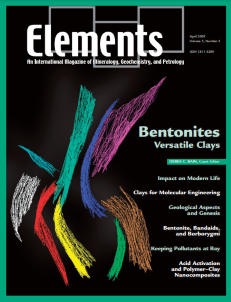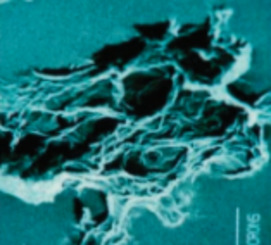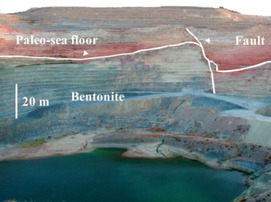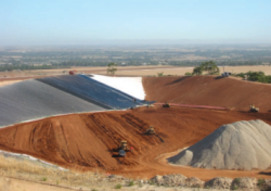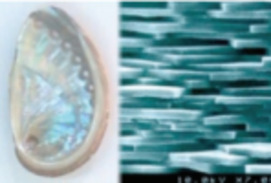
Bentonites - Versatile Clays
Derek C. Bain – Guest Editors
Table of Contents
Of all naturally occurring clays, benton ites are arguably the most interesting, versatile and useful. This issue of Elements describes how these fascinating materi als occur and how they are used in all manner of applications. Composed pre dominantly of swelling minerals (smec tites) and formed mainly from the alter ation of volcanoclastic rocks, bentonites are used by geologists for stratigraphic correlation. Bentonite deposits are mined worldwide as they are commercially very valuable. Because of their physicochemi cal properties, bentonites are used in a wide variety of industrial applications, including the drilling industry, found ries, civil engineering, adsorbents, filter ing, etc. Recent formulations of polymer– smectite nanocomposites have been used in industry to make new materials with amazing properties and diverse applications. Bentonites play an important role in the protection of the environment from industrial waste and pollutants and have also been used in medical applications in human health.
Bentonite and Its Impact on Modern Life
Bentonites – Clays for Molecular Engineering
Geological Aspects and Genesis of Bentonites
Bentonite, Bandaids, and Borborygmi
Bentonite Clay Keeps Pollutants at Bay
Acid Activation of Bentonites and Polymer–Clay Nanocomposites
Advanced Mineral Technologies
Amcol International
Excalibur Mineral Corporation
ioGlobal
RockWare
Savillex
Smart Elements
v5n3 Gems
Guest editor: Emmanuel Fritsch (Université de Nantes – CNRS) and Benjamin Rondeau (Université de Nantes – CNRS)
Most gems are natural minerals, which, although scarce and small, have a major impact on society. Their value is directly related to proper identifi cation. The determination of the species is key, of course, and must be done nondestructively. This is where classical tools of mineralogy come into play. However, other issues are paramount: Has this gem been treated? Is it natural or was it grown in a laboratory? For certain varieties, be ing able to tell the geographical provenance may enhance value considerably. These issues neces sitate crosslinking the formation of gems with their traceelement chemistry. These unusual mineralogical and geochemical challenges make the specificity of gemology, a new and growing science, one of the possible futures of mineralogy.
Gemology: The Developing Science of Gems Emmanuel Fritsch (Université de Nantes – CNRS) and Benjamin Rondeau (Université de Nantes – CNRS)
- Gem Formation, Production, and Exploration: Why Gem Deposits Are Rare and What is Being Done to Find Them Lee A. Groat (University of British Columbia) and Brendan M. Laurs (Gemological Institute of America)
- The Geochemistry of Gems and Its Relevance to Gemology: Different Traces, Different Prices George R. Rossman (California Institute of Technology)
- The Identification of Faceted Gemstones: From the Naked Eye to Laboratory Techniques Bertrand Devouard Université Blaise Pascal – CNRS) and Franck Notari (GemtechLab)
- Seeking Low-Cost Perfection: Synthetic Gems Robert E. Kane (Fine Gems International)
- Laboratory-Treated Gemstones James E. Shigley (Gemological Institute of America) and Shane F. McClure (Gemological Institute of America)
- Pearls and Corals: “Trendy Biomineralizations” Jean-Pierre Gauthier Lyon) and Stefanos Karampelas (University of Thessaloniki and Université de Nantes)
- Scientific Exploration of the Moon (February 2009)
- Bentonites – Versatile Clays (April 2009)
- Gems (June 2009)
- Mineral Magmatism: From Microbes to Meteorites (August 2009)
- Gold (October 2009)
- Metal Stable Isotopes: Signals in the Environment (December 2009)
Download 2009 Thematic Preview


